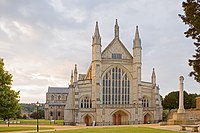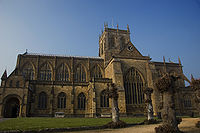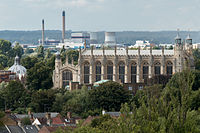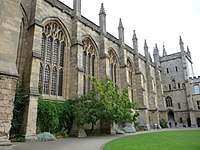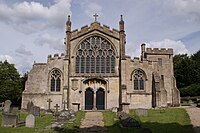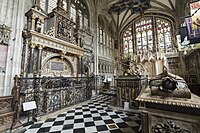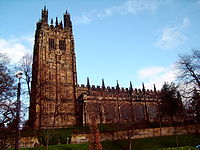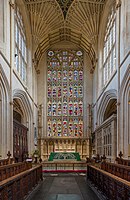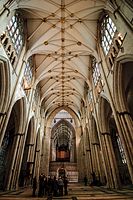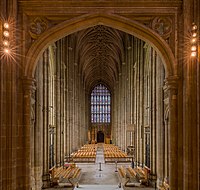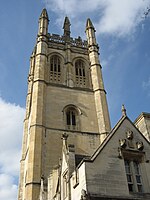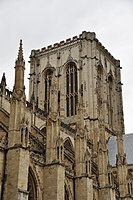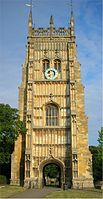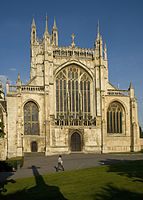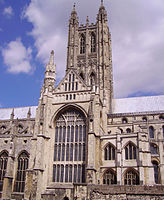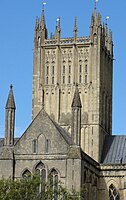Perpendicular Gothic


Perpendicular Gothic(alsoPerpendicular,Rectilinear,orThird Pointed) architecture was the third and final style ofEnglish Gothic architecturedeveloped in theKingdom of Englandduring theLate Middle Ages,typified by large windows,four-centred arches,straight vertical and horizontal lines in thetracery,and regular arch-topped rectangular panelling.[1][2]Perpendicular was the prevailing style ofLate Gothic architectureinEnglandfrom the 14th century to the 17th century.[1][2]Perpendicular was unique to the country: no equivalent arose inContinental Europeor elsewhere in theBritish Isles.[1]Of all the Gothicarchitectural styles,Perpendicular was the first to experience a second wave of popularity from the 18th century on inGothic Revival architecture.[1]
Thepointed archesused in Perpendicular were oftenfour-centred arches,allowing them to be rather wider and flatter than in other Gothic styles.[1]Perpendiculartraceryis characterized bymullionsthat rise vertically as far as thesoffitof the window, with horizontaltransomsfrequently decorated with miniaturecrenellations.[1]Blind panels covering the walls continued the strong straight lines of verticals and horizontals established by the tracery. Together with flattened arches and roofs, crenellations,hood mouldings,lierne vaulting,andfan vaultingwere the typical stylistic features.[1]
The first Perpendicular style building was designed inc. 1332byWilliam de Ramsey:achapter houseforOld St Paul's Cathedral,thecathedralof thebishop of London.[1]ThechancelofGloucester Cathedral(c. 1337–1357) and its latter 14th-centurycloistersare early examples.[1]Four-centred arches were often used, andlierne vaultsseen in early buildings were developed intofan vaults,first at the latter 14th-century chapter house ofHereford Cathedral(demolished 1769) andcloistersatGloucester,and then atReginald Ely'sKing's College Chapel, Cambridge(1446–1461) and the brothersWilliamandRobert Vertue'sHenry VII Chapel(c. 1503–1512) atWestminster Abbey.[1][3][4]
The architect and art historianThomas Rickman'sAttempt to Discriminate the Style of Architecture in England,first published in 1812, divided Gothic architecture in the British Isles into three stylistic periods.[5]The third and final style –Perpendicular– Rickman characterised as mostly belonging to buildings built from the reign ofRichard II(r. 1377–1399) to that ofHenry VIII(r. 1509–1547).[5]From the 15th century, under theHouse of Tudor,the prevailing Perpendicular style is commonly known asTudor architecture,being ultimately succeeded byElizabethan architectureandRenaissance architectureunderElizabeth I(r. 1558–1603).[6]Rickman had excluded from his scheme most new buildings after Henry VIII's reign, calling the style of "additions and rebuilding" in the later 16th and earlier 17th centuries "often much debased".[5]
Perpendicular followed theDecorated Gothic(or Second Pointed) style and preceded the arrival ofRenaissanceelements in Tudor and Elizabethan architecture.[7]As aLate Gothicstyle contemporary withFlamboyantinFranceand elsewhere in Europe, the heyday of Perpendicular is traditionally dated from 1377 until 1547, or from the beginning of the reign ofRichard IIto the beginning the reign ofEdward VI.[8]Though the style rarely appeared on the European continent, it was dominant in England until the mid-16th century.[9]
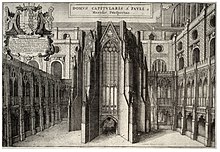


History[edit]
In 1906William Lethaby,Surveyor of the Fabric of Westminster Abbey, proposed that the origin of the Perpendicular style was to be found not in 14th-centuryGloucester,as was traditionally argued, but in London, where the court of theHouse of Plantagenetwas based atWestminster PalacebesideWestminster Abbey.[10]The cathedral of London, theepiscopal seeof the third-most senior bishop in theChurch of England,was thenOld St Paul's Cathedral.According to the architectural historianJohn Harvey,the octagonal chapter house of St Paul's, built about 1332 byWilliam Ramseyfor the cathedralcanons,was the earliest example of Perpendicular Gothic.[11][12]Alec Clifton-Tayloragreed that St Paul's chapter house and St Stephen's Chapel at Westminster Palace predate the early Perpendicular work at Gloucester.[13]In the early 21st century the outline of the foundations of the chapter house was made visible in the redeveloped south churchyard of the present 17th-century cathedral.[14]
The chapter house at St Paul's was built under the direction of William de Ramsey, who had worked on earlier phases of the still-unfinished St Stephens's Chapel. Ramsey extended the stone mullions of the windows downwards on the walls. At the top of each window he made a four-centred arch which became a distinctive feature of Perpendicular.[11][9]Along with rest of Old St Paul's, the chapter house was destroyed by theGreat Fire of Londonin 1666.
Elements of early Perpendicular are also known fromSt Stephen's Chapelat Westminster Palace, a palatine chapel built by KingEdward Ifollowing the model ofSainte-Chapelleat thePalais de la Citéinmedieval Paris.[11]It was built in phases over a long period, from 1292 until 1348, though today only the crypt exists. The architect of the early building wasMichael of Canterbury,followed in 1323 by his son Thomas. One of the original decorative features was a kind of blind tracery; blank vertical panels with cusped, or angular tops in the interior; and, on the exterior, thin stonemullionsor ribs extending downward below the windows creating perpendicular spaces. These became the most characteristic feature of the style.[9]
The earliest Perpendicular in a major church is the choir of Gloucester Cathedral (1337–1350) constructed when the south transept and choir of the thenBenedictine abbeychurch (Gloucester was not a bishopric until after theDissolution of the Monasteries) were rebuilt in 1331–1350. It was likely the work of one of the royal architects, either William de Ramsey, who had worked on the London cathedral chapter house, or Thomas of Canterbury, who was architect to the king when the transept of Gloucester Cathedral was begun. The architect preserved the original 11th-century walls, covering them with Flamboyant mullions and panels. The east window of Gloucester choir has a Tudor arch, filling the wall with glass. The window tracery matches the tracery on the walls.[15]
During the reign ofEdward IIIthe style began to dominate at the Court, especially at the redevelopment of Windsor Castle, whereJohn Sponleedesigned the buildings to house Edward's neo-Arthurian fancies. Of these the Dean's Cloister and Aerary Porch survive and exhibit early Perpendicular blind tracery and lierne vaults.[16]
The style attained maturity underHenry YeveleandWilliam Wynfordin the later 14th century. Yevele designed works for the King and Court, such asWestminster Hall,Portchester Castleand the naves ofWestminster AbbeyandCanterbury Cathedral,while Wynford predominantly worked forBishop Wykehamof Winchester on the nave of thecathedralitself as well as his educational foundations ofNew College, OxfordandWinchester College.[17]By c.1400 the style was widespread across the country, from Melrose in Scotland to Wells in Somerset.
Under the piousHenry VIthe official style of the Court became relatively austere, as seen at the chapels ofKing's College, CambridgeandEton College.[18]However, the original intentions at both buildings are now obscured as the building work continued long after the King was overthrown, with design changes resulting in increasing ornamentation. The same process occurred at theDivinity School, Oxford.
In the later 15th century, the pendulum swung back towards elaboration, especially under the Tudors. John Harvey considered this change to be significant enough to meritTudor Gothicbeing considered as a separate style,[19]with greater continental influence, but this position is not widely held. At this period many of the most dazzling vaults were constructed, such as those byJohn WastellatPeterborough Abbey(now a cathedral) and King's College chapel. These were both straightforwardfan vaults,butpendant vaultingalso reached its apogee with those over St Frideswide's Priory (nowOxford Cathedral) and theHenry VII Chapelat Westminster Abbey, a major example of the late Perpendicular style. Another important example isSt George's ChapelatWindsor Castle,begun in 1475. The vault of the chapel was contracted to the master-mason John Aylmer in 1506.[20]
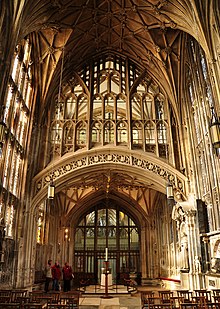
Characteristics[edit]
- Towerswere exceptionally tall, and frequently had battlements. Spires were less frequent than in earlier periods. Buttresses were often placed at the corners of the tower, the best position for providing maximum support. Notable Perpendicular towers include those ofYork Minsterand Gloucester Cathedral, and the churches of Boston (Lincolnshire)[clarification needed],Wrexham and Taunton.[21]
- Stained glass windowswere so large that the walls between were reduced to little more than piers. Horizontal mullions, called "transoms", often had to be added to the windows to give them greater stability.[22]
- Tracerywas a major feature of decoration. In the larger churches, the entire surface from ground to summit, including the battlements, was covered with panels of tracery composed of thin stone mullions. It also appeared frequently in the interior, and often carried the designs in the window tracery down to the floor.[21]Tracery designs were less varied, with three main types: angular reticulation, common in the west of England, panel tracery, seen in the east, and the Court style, characterised by sub-arches filled with inverted daggers in the side lights.[23]
- Roofswere frequently made of lead, and usually had a gentle slope, to make them easier for walking[citation needed].The roof timbers on the interior were often exposed to view from below, and had ornamental supports.[21]In this period thehammerbeam roofwas used over select high-status buildings.
- Vaultsof stone were frequently elaborate and highly decorative. The most common types on major buildings were fan vaults andlierne vaults,both of which could be further elaborated with pendants. The increased weight of the vaults caused by the ornament was countered by larger buttresses on the exterior.[21]
- Columnswere generally octagonal in section, with octagonal bases and capitals. In greater churches shafting was commonplace, and could be carried up above the capitals to unify the elevation vertically. The capitals were usually decorated with moulded or carved oak leaves, or with corbels of shields or armorial symbols, or with theTudor rose.[24]In more advanced buildings, capitals became less prominent.
- Fourth-centredarchesorTudor archeswere commonly used in windows and tracery and for vaults and doorways, though thetwo-centred archdominated until late in the period.
- The interiors had richly carvedwoodwork,particularly in the choir stalls, which often featured carved grotesque figures on the bench ends called "poppy heads", fromFrench:poupée,lit. 'doll'.[24]Pulpits and benches became more common in churches with the increased emphasis on preaching.Chantry chapelsappeared in major churches, either as screened-off sections or structural editions, paid for by wealthy individuals or guilds.
Examples[edit]
- Palace of Westminster,St Stephen's Chapel (largely destroyed), Westminster Hall
- Old St Paul's, London,Chapter House (destroyed)
- Gloucester Cathedral,recasing of transepts, choir and presbytery, cloister, tower, Lady Chapel, west front
- Hereford Cathedral,Chapter House (destroyed)
- Windsor Castle,Dean's Cloister, St George's Chapel
- Westminster Abbey,cloister (heavily restored), nave, Henry VI's Chantry, Henry VII's Chapel
- Winchester Cathedral,west front, recasing of nave, choir
- Canterbury Cathedral,nave, cloister, remodelling of Chapter House, south-west tower, Bell Harry Tower, Christ Church Gate
- New College, Oxford
- Winchester College
- King's College, Cambridge,Chapel
- Eton College
- Maidstone College
- Norwich Cathedral,cloister, choir clerestory, vaults, spire
- York Minster,retrochoir, choir, towers
- Durham Cathedral,central tower
- Tattershall,Castle tower and collegiate church
- Coventry Cathedral(formerly St Michael's Church, now in ruins)
- Magdalen College, Oxford
- Christ Church, Oxford,vault of cathedral, Tom Quad (never fully completed)
- St Mary's Church, Warwick,choir and Beaufort Chapel
- Peterborough Cathedral,New Building (retrochoir)
- Great Malvern Priory,everything except the nave arcades
- Melrose Abbey,presbytery
- Lavenham Church
- Long Melford Church
- Bath Abbey
- Manchester Cathedral
- South Wingfield Manor
- Hampton Court Palace(with some early Renaissance influence)
Gallery[edit]
-
Winchester Cathedralwest front
-
Henry VII ChapelatWestminster Abbey(1503–), with Perpendicular tracery and blind panels.
-
Edington Priorywest front: Decorated and Perpendicular
-
Beauchamp Chapel,Collegiate Church of St Mary, Warwick
-
Manchester Cathedralchancel
-
Hall ofChrist Church, Oxford
-
Hull Minsternave
-
Gloucester Cathedral,choir and chancel
-
Bath Abbeychancel
-
York Minsterchancel, looking west
-
York Minstercrossing tower
-
Evesham Abbeybell tower
-
Bridlington Priorywest front
-
Gloucester Cathedraleast end (1331–1350), with a four-centred arch window
-
Canterbury Cathedralcrossing tower and transepts
-
Wells Cathedralcrossing tower
-
Beverley Minsterwest front
-
Norwich Cathedralspire and west window
-
Chichester Cathedralspire
References[edit]
- ^abcdefghijCurl, James Stevens; Wilson, Susan, eds. (2015),"Perpendicular",A Dictionary of Architecture and Landscape Architecture(3rd ed.), Oxford University Press,doi:10.1093/acref/9780199674985.001.0001,ISBN978-0-19-967498-5,retrieved2020-05-16
- ^abFraser, Murray, ed. (2018),"Perpendicular Gothic",Sir Banister Fletcher Glossary,Royal Institute of British Architectsand theUniversity of London,doi:10.5040/9781350122741.1001816,ISBN978-1-350-12274-1,retrieved2020-08-26,
English idiom from about 1330 to 1640, characterised by large windows, regularity of ornate detailing, and grids of panelling that extend over walls, windows and vaults.
- ^Curl, James Stevens; Wilson, Susan, eds. (2015),"Ely, Reginald",A Dictionary of Architecture and Landscape Architecture,Oxford University Press,doi:10.1093/acref/9780199674985.001.0001,ISBN978-0-19-967498-5,retrieved2020-05-16
- ^Curl, James Stevens; Wilson, Susan, eds. (2015),"Vertue, Robert",A Dictionary of Architecture and Landscape Architecture,Oxford University Press,doi:10.1093/acref/9780199674985.001.0001,ISBN978-0-19-967498-5,retrieved2020-05-16
- ^abcRickman, Thomas(1848) [1812].An Attempt to Discriminate the Styles of Architecture in England: From the Conquest to the Reformation(5th ed.). London: J. H. Parker. pp. lxiii.
- ^Curl, James Stevens; Wilson, Susan, eds. (2015),"Tudor",A Dictionary of Architecture and Landscape Architecture(3rd ed.), Oxford University Press,doi:10.1093/acref/9780199674985.001.0001,ISBN978-0-19-967498-5,retrieved2020-04-09
- ^Encyclopaedia Britannica on-line, "Perpendicular Gothic", retrieved August 19, 2020
- ^Smith 1922,p. loc. 204.
- ^abcWatkin 1986,p. 152.
- ^Lethaby, William Richard(1906).Westminster Abbey & the King's Craftsmen: A Study of Mediæval Building.E. P. Dutton.ISBN978-0-405-08745-5.
- ^abcHarvey, John H. (1946)."St. Stephen's Chapel and the Origin of the Perpendicular Style".The Burlington Magazine for Connoisseurs.88(521): 192–199.ISSN0951-0788.JSTOR869300.
- ^Harvey, John Hooper(1978).The Perpendicular Style, 1330-1485.London: Batsford. p. 105.ISBN978-0-7134-1610-7.
- ^Clifton-Taylor, Alec (1967).The Cathedrals of England.World of Art. London: Thames & Hudson. p. 196.ISBN0-500-20062-9.OCLC2631377.
- ^Peterkin, Tom (2008-06-04)."St Paul's Cathedral opens new South Churchyard".The Daily Telegraph.ISSN0307-1235.Archivedfrom the original on 2022-01-12.Retrieved2020-08-28.
- ^Watkin 1986,p. 153.
- ^Harvey, John (1978).The Perpendicular Style.London: Batsford. p. 84.ISBN0 7134 1610 6.
- ^Harvey, John (1978).The Perpendicular Style.London: Batsford. pp. 97–136.ISBN0 7134 1610 6.
- ^Harvey, John (1978).The Perpendicular Style.London: Batsford. pp. 185–186.ISBN0 7134 1610 6.
- ^Harvey, John (1978).The Perpendicular Style.London: Batsford. p. 13.ISBN0 7134 1610 6.
- ^Curl, James Stevens; Wilson, Susan, eds. (2015),"Aylmer, John",A Dictionary of Architecture and Landscape Architecture(3rd ed.), Oxford University Press,doi:10.1093/acref/9780199674985.001.0001,ISBN978-0-19-967498-5,retrieved2020-05-16
- ^abcdSmith 1922,335.
- ^Smith 1922,327.
- ^Harvey, John (1978).The Perpendicular Style.London: Batsford. pp. 63, 71, 153.ISBN0 7134 1610 6.
- ^abSmith 1922,352.
Bibliography[edit]
- Bechmann, Roland (2017).Les Racines des Cathédrals(in French). Paris: Payot.ISBN978-2-228-90651-7.
- Ducher, Robert,Caractéristique des Styles,(1988), Flammarion, Paris (in French);ISBN2-08-011539-1
- Harvey, John(1961).English Cathedrals.Batsford.OCLC2437034.
- Smith, A. Freeman (1922).English Church Architecture of the Middle Ages – an Elementary Handbook.T. Fisher Unwin.
- Martin, G. H.; Highfield, J. R. L. (1997).A history of Merton College, Oxford.Oxford:Oxford University Press.ISBN0-19-920183-8.
- Watkin, David (1986).A History of Western Architecture.Barrie and Jenkins.ISBN0-7126-1279-3.

